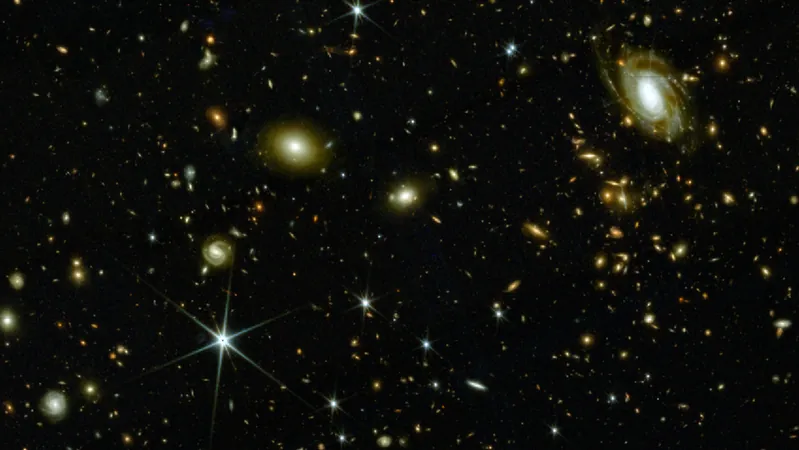
Unveiling the Early Universe: James Webb Space Telescope's Groundbreaking Galactic Map
2025-06-05
Author: Lok
A Cosmic Revelation from the James Webb Space Telescope
Astronomers have made a monumental breakthrough with the James Webb Space Telescope (JWST), unveiling the largest ever map of the early universe. This stunning cosmic panorama not only captivates seasoned scientists but also stirs the imagination of curious stargazers.
The COSMOS-Web Project: A Skywide Survey Like No Other
The awe-inspiring images stem from COSMOS-Web, the most extensive observational project undertaken by JWST in its first year. This ambitious survey spanned an area of sky equivalent to three full moons aligned side-by-side, marking the telescope's broadest view to date. By stitching together over 10,000 exposures, astronomers revealed nearly 800,000 galaxies, many of which date back to the universe's formative years.
Lead researcher Jeyhan Kartaltepe from the Rochester Institute of Technology expressed, "I don't know if the James Webb Space Telescope will cover an area this large again, making this a valuable data set for many years to come." This treasure trove of data is now accessible to researchers worldwide, opening pathways for groundbreaking discoveries.
Breaking New Ground in Cosmic Exploration
The COSMOS-Web project secured over 200 hours of observation time — the largest allocation for any study in the JWST's inaugural year. Whereas most JWST research zeroes in on narrow sections of the sky, this project aimed for a broader scope, discovering ten times more galaxies than initially anticipated.
Postdoctoral researcher Maximilien Franco commented on the thrill of unveiling previously invisible galaxies, stating, "It was incredible to finally see them appear on our screens." The expansive views provided by JWST allow for detailed catalogs of these distant galaxies and insights into how their characteristics evolve based on their cosmic environments.
Mapping the Birth of Galaxies and Reionization Era
Among the project's goals was to chart the earliest structures of the universe during the Reionization Era, over 13 billion years ago, when the first galaxies emerged from the hydrogen fog that enveloped the cosmos. Kartaltepe and her team are using early galaxies as markers to assess the size of 'reionization bubbles' — vast areas where starlight began to clear the primordial haze.
Innovative Techniques and Data Processing Challenges
The team also published several scientific papers, one of which tests a cutting-edge machine learning technique to determine the physical properties of galaxies in their massive dataset. They adopted a new approach to measuring the brightness of distant galaxies, enhancing accuracy by modeling how light spreads across galaxies.
Despite unexpected challenges, such as noise and distortions in the images, the JWST has exceeded pre-launch expectations for detecting faint and distant galaxies. Kartaltepe remarked, "The reality turned out to be better — we were able to go deeper than we expected." The invaluable catalog from this mission holds incredible potential for future discoveries.
The Journey Ahead: Exploring the Unknown
As the data continues to unfold, researchers remain excited about the vast unknowns still awaiting exploration. The JWST's groundbreaking work lays the foundation for a new era in our understanding of the universe, promising many more revelations to come.



 Brasil (PT)
Brasil (PT)
 Canada (EN)
Canada (EN)
 Chile (ES)
Chile (ES)
 Česko (CS)
Česko (CS)
 대한민국 (KO)
대한민국 (KO)
 España (ES)
España (ES)
 France (FR)
France (FR)
 Hong Kong (EN)
Hong Kong (EN)
 Italia (IT)
Italia (IT)
 日本 (JA)
日本 (JA)
 Magyarország (HU)
Magyarország (HU)
 Norge (NO)
Norge (NO)
 Polska (PL)
Polska (PL)
 Schweiz (DE)
Schweiz (DE)
 Singapore (EN)
Singapore (EN)
 Sverige (SV)
Sverige (SV)
 Suomi (FI)
Suomi (FI)
 Türkiye (TR)
Türkiye (TR)
 الإمارات العربية المتحدة (AR)
الإمارات العربية المتحدة (AR)